Menus
- The first two-stroke superbike
- Irrhythmic moaning of the two-stroke triplet
- Technical specifications

Nakamura
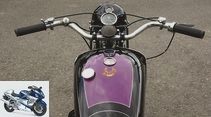
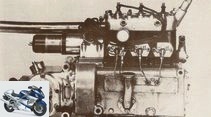
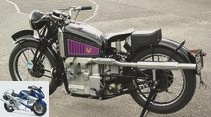
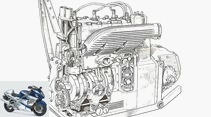
10 photos
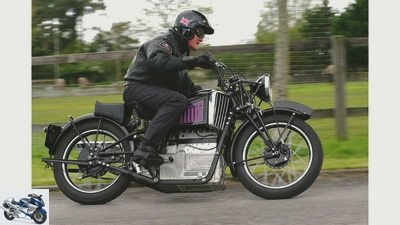
Nakamura
1/10
Scott Model 3S – water-cooled in-line three-cylinder two-stroke engines from 1934.

Nakamura
2/10
The driver adjusts the ignition timing by turning the handle on the left end of the handlebar.
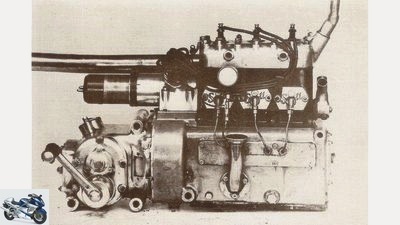
Nakamura
3/10
The 747 cubic centimeter prototype was created by Bill Cull, who joined Scott in 1931, from which the enthusiastic motorcyclist finally derived the mighty 1000cc version of the three-cylinder two-stroke engine.
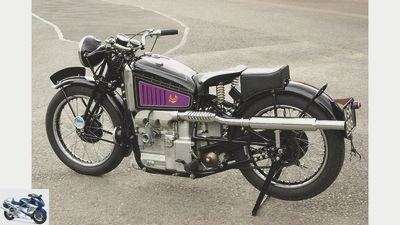
Nakamura
4/10
The Scott offers a gentlemanly driving experience – thanks to a relaxed sitting posture and high-torque motor.
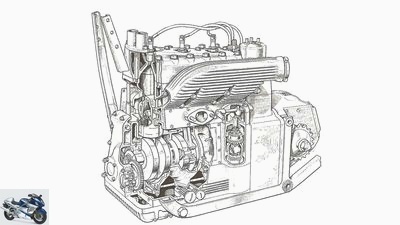
Nakamura
5/10
Three relatively small crank chambers in the large engine housing. Next to the flange for the carburetor connection is the main oil pump for the five liters of lubricant that romp around in the lower part of the housing.
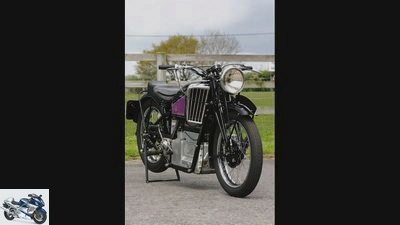
Nakamura
6/10
With 48 hp from 986 cm³ as powerful as the Brough Superior SS100, but a full 23 kilograms lighter.
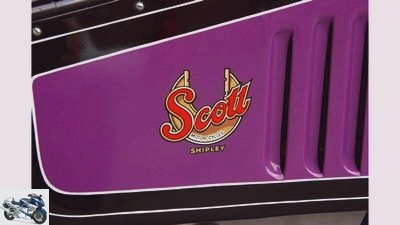
Nakamura
7/10
Filigree Scott logo on the side covers painted in purple. Why purple? It was the color of Scott’s sister Alice’s favorite dress.
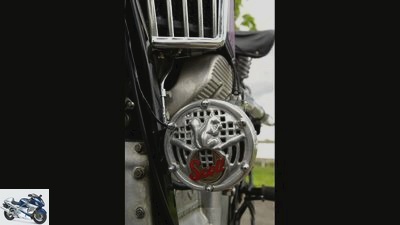
Nakamura
8/10
Conclusive: Scott logo with croissant (right), based on the successful Squirrel model.
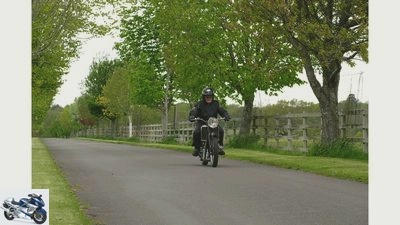
Nakamura
9/10
In advertisements, the Scott is touted as a six-cylinder two-wheeled vehicle for £ 115.
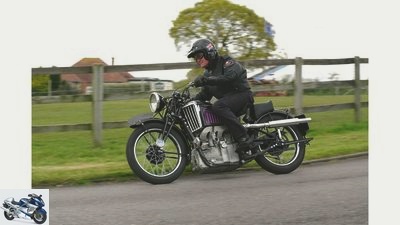
Nakamura
10/10
Scott Model 3S.
On the move with the Scott Model 3S
The first two-stroke superbike
Content of
Those who speak of water-cooled in-line three-cylinder two-stroke engines today usually have Suzuki’s GT 750 in mind. Long before that, namely in 1934, the Scott Model 3S anticipated this concept. And created a milestone with the 1000, which unfortunately only reached single-digit numbers.
Ever since Edward Turner created the Triumph Speed Twin in 1937, an engine concept has manifested itself as the typically British one: the ohv parallel twin. At the time, British engineers were among the most innovative free thinkers in terms of engine construction – perhaps the most inventive among them, the founder of S.cott Motorcycle Company, Alfred Angas Scott. He was one of the key figures in the history of the motorcycle as we know it today, a shrewd inventor who is still considered the first serious advocate of the high-performance two-stroke engine and who has applied for more than 60 patents. Among other things, the Kickstarter, the foot control, the telescopic fork and much more can be traced back to him.
Buy complete article

On the move with the Scott Model 3S
The first two-stroke superbike
Failed marine project as the origin
Unlike many other British brands, Scott managed to stay afloat by building generators and pumps thanks to contracts in force with the Department of Defense. In the 1930s, Scott only built an average of about 150 motorcycles a year, and its importance in racing was also dwindling. But it was precisely thanks to these military contracts that Bill Cull, himself an enthusiastic motorcyclist, joined Scott as technical director in 1931. It was he who decided to develop a three-cylinder luxury bike that would be in the top segment, where there was a certain demand in the market. Brough Superior and other prestige brands saw significant growth.
In 1932, Cull had designed a 747 cc three-cylinder two-stroke engine for an ultimately failed marine project – this now represented the origin of the Scott three-cylinder motorcycle, which he put on wheels in 1933. Even if the prototype was rather clumsy and inelegant, and although it was rather unwieldy and commuted across the entire width of the road at the respectable, achievable speeds of up to 140 km / h, head tester Allan Jefferies attested the bike a coherent basic concept. Work was carried out on eliminating the weaknesses and the journalists’ first test drives received widespread good reviews and even hymns of praise for the engine performance.
Nakamura
With 48 hp from 986 cm³ as powerful as the Brough Superior SS100, but a full 23 kilograms lighter.
When the so-called Model 3S was finally presented at the Olympia Motorcycle Show in London at the end of 1934, it was a sensation. The water-cooled three-cylinder two-stroke engine had been completely redesigned and its displacement increased to 986 cm³, plus a four-speed gearbox and footshift. The bike, touted by Scott in a brochure as a “modern six-cylinder car on two wheels”, was offered for 115 pounds in 1936, but hardly found any buyers.
Laborious and conscientious detective work by the Scott Owners Club revealed that only nine were actually built. One remained in company ownership, for the personal use of creator Bill Cull. The French Scott importer also had a copy, including a replacement engine (four of which were made). That engine was finally sold on to Germany – to the DKW factory. From 1939 DKW produced its own 900 cc three-cylinder two-stroke engine, undoubtedly inspired by the Scott Drilling. From 1955 on, this also powered the Wartburg, which was produced in the old BMW plant in Eisenach. The highlight could even have been a 100 hp straight six-cylinder engine consisting of two coupled Scott three-series, which was intended for use in an Aston Martin sports car, but the outbreak of World War II ruined this project.
Only five of the nine Scott Model 3S built have survived to this day, but the only one in running order is definitely the exhibition bike in the Sammy Miller Museum (www.sammymiller.co.uk). In 1990 Miller got hold of this from Ryan Holder, together with four cylinder blocks and various frames as well as 600 construction drawings of inestimable value for the restoration. The main obstacle: the bike had been parked outside, with the spark plugs removed, and the crankcase full of water. The engine, which was actually as good as new, had to be completely overhauled. Fortunately, the nose pistons could be saved, the remaining work turned out to be expensive enough. Miller is not sure whether the piece of jewelery he bought is Holders Ex-machine, or even Bill Scull’s factory model, after all, it does not have the tanks that are mounted on the rear of the later models. What they all have in common, however, is the 48 hp 986 cm³ three-cylinder – as powerful as a Brough Superior SS100, the queen of the road, which, however, weighed 23 kilograms more.
The elaborately designed two-stroke engine can boast a number of technical refinements. The partition walls of the horizontally divided crankcase (so that undivided connecting rod ends can be used) were formed by light metal disks, which were slightly smaller in diameter than the lifting disks of the 120-degree crankshaft. No less than three oil pumps ensured the sensible distribution of the five liters of lubricant, a main pump coupled with the carburetor actuation and two gear pumps on the front. The excess oil in the crank chambers was sucked back into the reservoir through a filter – a rare case in a two-stroke engine with dry sump lubrication. The oil is supplied to the cylinder liners in a sophisticated way, in that oil is pushed up through the hollow cylinder studs into small chambers that have access to the races at several points around the cylinder circumference. The already mentioned nose pistons support the gas exchange in a clever way, the coil ignition provides the necessary ignition sparks, the ignition adjustment (which is extremely effective here) is done by hand using a twist grip mounted on the left of the handlebar. The transmission, which has already been refurbished twice with new gears, should now shift better, says Miller.
Irrhythmic moaning of the two-stroke triplet
Well, it’s time to find out for yourself how well, or even impressively, the Scott drives. First the start – it’s child’s play: flood the single carburetor well, pass it through a few times so that the crank chambers fill with mixture, wait briefly, switch on the ignition and with a more emphatic step on the kick starter, you can hear a refreshing engine sound.
Nakamura
In advertisements, the Scott is touted as a six-cylinder two-wheeled vehicle for £ 115.
Hardly any mechanical noises, just the typical, slightly irregular moaning of a two-stroke triplet. It sounds less like my once-owned GT 750, more like the Wartburg station wagon that we used as a service car for racing a good 20 years ago. Vibrations are hardly an issue, even though the engine is rigidly screwed into the tubular steel frame. The 222 kilogram bike has to do without rear suspension, but offers a relaxed, upright sitting position on the wide, one-piece handlebars and, together with the extremely smooth, extremely high-torque motor, offers a gentlemen-worthy driving experience.
The Webb parallelogram fork easily gets a little pumping and could definitely use something like damping. Despite the long wheelbase, I found nothing wrong with the handling and the effort required to change direction. Nor can I detect the pendulum that was once criticized by Jefferies. In view of the lack of braking action of the engine, the Scott even comes to a standstill reasonably quickly, thanks to the 178 millimeter drum brake at the front and above all the large 255 version at the rear. Reassuring, given the speeds that can be achieved. Although the Smith speedometer refuses to display it, the Scott casually shakes the 100 km / h displayed by the photographer’s car at half-throttle. Open the throttle at low speed, the triplet responds with a spontaneous reaction and a gentle, steady increase in speed. Not brutal, due to the weight to be dragged, but neat.
Accelerating is generally made more difficult by the poor shiftability of the transmission. Gear changes have to be slow and still remain a game of chance: can or not? However, Miller sums it up when he says with conviction: “Everyone is a Scott man if they are into classics. The bike has so much character, with its howling exhaust sound, its driving dynamics thanks to the high-torque engine. This three-cylinder bike is an icon, and it’s a shame it never really went into production. It was the first two-stroke superbike and it was years ahead of its time. ”Nobody could have said it more accurately.
Technical specifications
Nakamura
Three relatively small crank chambers in the large engine housing. Next to the flange for the carburetor connection is the main oil pump for the five liters of lubricant that romp around in the lower part of the housing.
Engine:
Water-cooled three-cylinder two-stroke engine, bore x stroke 73 x 78 mm, displacement 986 cm³, 48 hp at 5200 / min, compression 5.8: 1, a 28 mm Amal carburetor, coil ignition, single-disc dry clutch, foot-shifted four-speed gearbox, secondary drive by chain
Landing gear:
Two-loop frame made of tubular steel, Webb parallelogram fork at the front, unsprung rear wheel, wire-spoke wheels front and rear, tires 3.25 x 19 front, 3.25 / 3.50 x 19 rear, simplex drum brake front, Ø 178 mm, simplex drum brake rear, Ø 255 mm
Measurements and weight:
Wheelbase 1420 mm, tank capacity 11 liters, weight approx. 222 kg
Driving performance:
Vmax 140 km / h
Related articles
-
On the move: Moto Guzzi California
Moto Guzzi On the move: Moto Guzzi California and California Vintage California Dreams Content of In the 1970s, the Beach Boys introduced a new, dynamic…
-
On the move: 30 years of GS models from BMW
Frank Herzog 71 photos BMW 1/71 1985: Little Gaston Rahier fights his way through the desert again with his huge HPN boxer and can successfully defend…
-
On the move: Benelli 750 Sei, Honda CBX 1000, Kawasaki Z 1300
Bilski 17th photos Bilski 1/17 Who is the widest in the whole country? The angle of spread of the driver’s legs provide information. Bilski 2/17 With…
-
On the move: OSSA 250 Trial MAR
Jahn On the move: OSSA 250 Trial MAR Werner – rock hard Content of Trial legend Mick Andrews crowned OSSA‘s successful streak with two European…
-
On the move with Kawasaki GPZ 900 R and Yamaha FJ 1100
fact 39 photos fact 1/39 Hurry with a while, always slowly with the young horses – sayings like these were definitely not up for debate when the new,…
-
On the move with the Honda CB 900 F Bol d‘Or, Honda CBX, Kawasaki Z 1000 ST and Kawasaki Z 1300
Arturo Rivas 45 photos Arturo Rivas 1/45 Six against four for the first: Honda CBX and Honda CB 900 Bol d’Or. Arturo Rivas 2/45 Honda CBX. Arturo Rivas…
-
On the move with the Suzuki GS 550 E and Suzuki GT 550
30th photos www. 1/30 In the mid-1970s, Suzuki was pretty late in setting the course for the future. It was not until 1976 that…
-
On the move: Triumph Bonneville and Yamaha TX 750
www. 40 photos , archive 1/40 When comparing the British original Triumph Bonneville 750 with the Japanese answer, the Yamaha TX…
-
On the move: Walter-Suzuki GT 1000
fact On the move: Walter-Suzuki GT 1000 The really big thing Content of If so, then, Walter Friedrichs said to himself as he set about reinventing the…
-
KTM 640 LC4 Supermoto model 2005
KTM 640 LC4 Supermoto model 2005 Active breathing Cleared airways and two mufflers are supposed to spice up the KTM 640 Supermoto. D. as the LC4 engine…